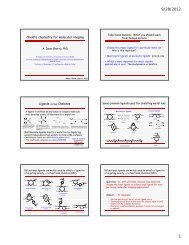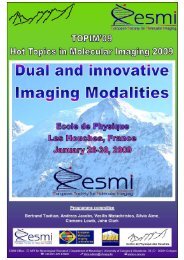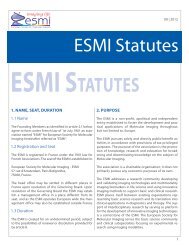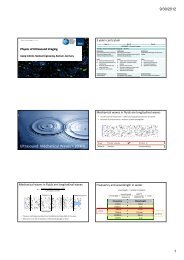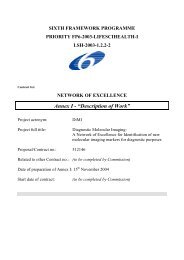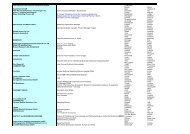5th EuropEan MolEcular IMagIng MEEtIng - ESMI
5th EuropEan MolEcular IMagIng MEEtIng - ESMI
5th EuropEan MolEcular IMagIng MEEtIng - ESMI
You also want an ePaper? Increase the reach of your titles
YUMPU automatically turns print PDFs into web optimized ePapers that Google loves.
<strong>5th</strong> <strong>EuropEan</strong> <strong>MolEcular</strong> <strong>IMagIng</strong> <strong>MEEtIng</strong> – EMIM2010<br />
Lanthanide-based in vivo luminescence imaging<br />
Petoud S. .<br />
CNRS, France<br />
spetoud@pitt.edu<br />
Introduction: Fluorescence and luminescence<br />
are detection techniques that possess important<br />
advantages for bioanalytical applications and<br />
biologic imaging: high sensitivity, versatility and<br />
low costs of instrumentation. A common characteristic<br />
of biologic analytes is their presence in<br />
small quantities among complex matrices such as<br />
blood, cells, tissue and organs. These matrices<br />
emit significant background fluorescence (autofluorescence),<br />
limiting detection sensitivity.<br />
The luminescence of lanthanide cations has several<br />
complementary advantages over the fluorescence<br />
of organic fluorophores and semiconductor<br />
nanocrystals, such as sharp emission bands for<br />
spectral discrimination from background emission,<br />
long luminescence lifetimes for temporal<br />
discrimination and strong resistance to photobleaching.<br />
In addition, several lanthanides emit<br />
near-infrared (NIR) photons that can cross deeply<br />
into tissues for non-invasive investigations and<br />
that result in improved detection sensitivity due<br />
to the absence of native NIR luminescence from<br />
tissues and cells. The main requirement to obtain<br />
lanthanide emission is to sensitize them with an<br />
appropriate chromophore.<br />
Methods: An innovative concept for such sensitization<br />
of lanthanide cations is proposed herein;<br />
the current limitation of low quantum yields<br />
experienced by most mononuclear lanthanide<br />
complexes is compensated for by using larger<br />
numbers of lanthanide cations and by maximizing<br />
the absorption of each discrete molecule,<br />
thereby increasing the number of emitted photons<br />
per unit of volume and the overall sensitivity<br />
of the measurement. To apply this concept, we<br />
are developing a family of dendrimer-naphthalimide<br />
ligands that are able to incorporate several<br />
lanthanide cations. Polyamidoamine (PAMAM)<br />
dendrimers have been chosen as a basis for these<br />
complexes because the oxygen atoms of the amido<br />
groups located along their branches can bind<br />
and protect the lanthanide cations inside the<br />
dendrimer core.1,2 Derivatives of naphthalimide<br />
groups, required for the sensitization of the lanthanide<br />
cations, are located at the branch termini.<br />
Our synthetic approach allows facile modification<br />
of the dendrimer complex for control over<br />
photophysical properties and solubility. It also<br />
provides for the attachment of different types<br />
of targeting agents such as peptides, oligonucleotides<br />
or proteins, as well as other sensing agents,<br />
to provide functionality to these compounds in a<br />
broad range of applications.<br />
Results: In this paper, we will describe several<br />
examples of luminescent polymetallic lanthanide<br />
complexes based on dendrimers. We will also<br />
present examples of their applications as reporters<br />
and sensors for biologic imaging in living cells<br />
and small animals.<br />
References:<br />
1. J. P. Cross, M. Lauz, P. D. Badger, S. Petoud, Journal of<br />
the American Chemical Society, 2004, 126, 16278.<br />
2. D. R. Kauffman, C. M. Shade, H. Uh, A. Star and S. Petoud,<br />
Nature Chemistry 2009, 1, 500.<br />
<strong>EuropEan</strong> SocIEty for <strong>MolEcular</strong> <strong>IMagIng</strong> – <strong>ESMI</strong><br />
day1<br />
Parallel Session 4: PROBES - supported by COST



